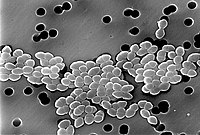
Photo from wikipedia
The main goal of the study was to analyse the occurrence of antibiotic-resistant bacterial strains in poultry in the Czech Republic in 1999-2000. The resistance was determined in 128 selected… Click to show full abstract
The main goal of the study was to analyse the occurrence of antibiotic-resistant bacterial strains in poultry in the Czech Republic in 1999-2000. The resistance was determined in 128 selected Escherichia coli, 88 Staphylococcus sp. and 228 Enterococcus sp. strains. The bacterial species were selected to represent gramnegatives and grampositives, the common part of intestinal microflora and also opportunistic pathogens. In Escherichia coli, 97% of strains were found to be resistant to tetracycline, 51% were resistant to ampicillin, and 31% were resistant to piperacillin. Increased frequencies of resistance to ofloxacin and ciprofloxacin (in 10% of the strains) were also found. In staphylococci, increased numbers of strains resistant to erythromycin (39%), clindamycin (19%), tetracycline (14%) and ofloxacin (13%) were observed. In enterococci, 80%, 59% and 34% of the strains were resistant to tetracycline, erythromycin or nitrofurantoin, respectively. A high-level resistance to streptomycin was proved in 22% of the strains. Eleven Enterococcus sp. strains were found to be resistant to vancomycin (vancomycin-resistant enterococci - VRE). Being of the clinical importance, the VRE strains were analysed in detail. Six VRE were identified as Enterococcus faecium VanA, three strains belonged to Enterococcus sp. group III VanB. The remaining two strains were classified as Enterococcus faecium VanB and Enterococcus faecalis VanB, respectively. Based on SmaI macrorestriction analysis, regardless of their resistance type, vancomycin-resistant Enterococcus faecium strains formed a cluster distinct from the control group of vancomycin sensitive strains. Furthermore, within the cluster of vancomycin resistant Enterococcus faecium strains, two clonal lines could be distinguished while the sensitive strains were more heterogeneous.
Journal Title: Veterinarni Medicina
Year Published: 2018
Link to full text (if available)
Share on Social Media: Sign Up to like & get
recommendations!